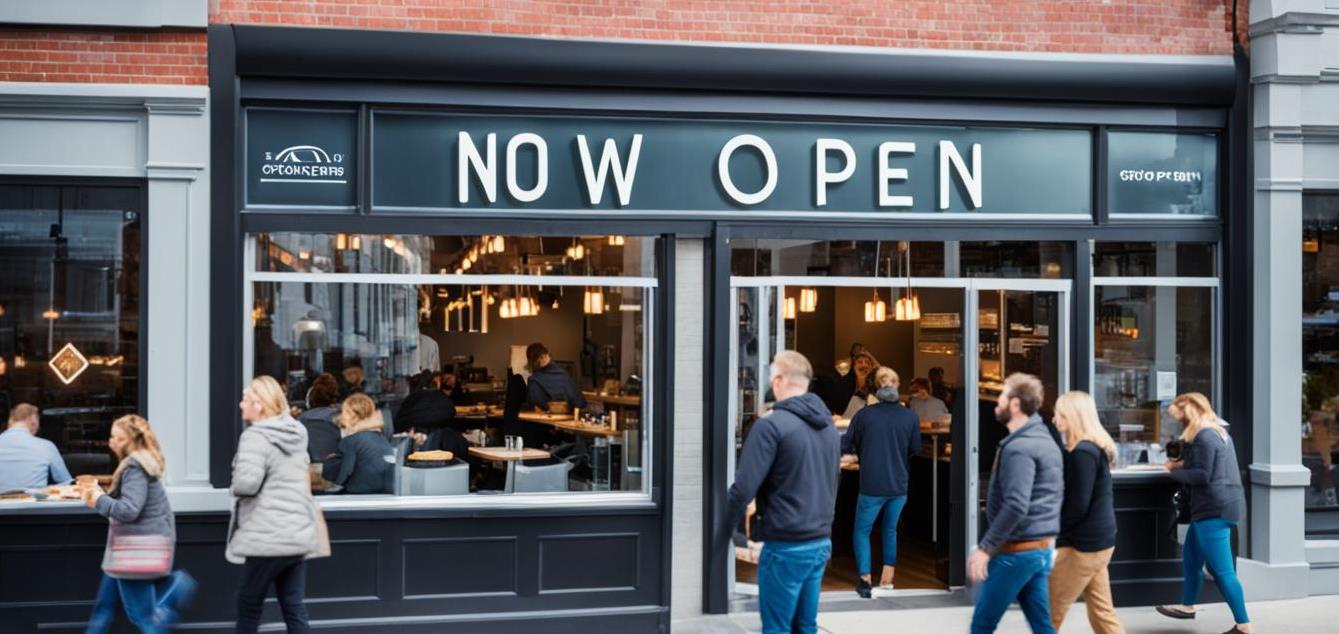
Starting a restaurant in the US can be a rewarding but challenging endeavor. With a high failure rate, it’s crucial to have a solid plan in place. Here, we’ll cover everything from finding the perfect location to creating a menu and implementing effective marketing strategies. We’ll also address key questions like the cost of opening a restaurant, standing out in a saturated market, and the profitability of restaurants in the USA. Whether you’re dreaming of a fine dining establishment or a trendy café, we’ll equip you with the knowledge on how to start a restaurant and insights you need to succeed in the competitive restaurant industry.
How to Start a Restaurant in the US
Restaurant Concept

Choosing a niche or concept is one of the first steps in starting a restaurant. This involves identifying the type of cuisine, service style, and target audience. It’s crucial to research current restaurant trends in the US to stay relevant and appealing to customers. When selecting a concept, consider the balance between uniqueness and popularity, as well as the potential market demand. Conducting thorough market research will help validate your concept and make necessary adjustments for success.
Choosing a Niche
When choosing a niche for your restaurant, consider the following factors:
- Local Market Analysis: Research the existing restaurants in your area to identify any gaps or unmet needs. Determine what types of cuisines or dining experiences are currently popular and if there is an opportunity to offer something different.
- Target Audience: Understand your target audience – their demographics, preferences, and dining habits. Tailor your niche to cater to their needs and desires.
- Passion and Expertise: Consider your own passion and expertise in a specific cuisine or dining style. Choosing a niche that aligns with your knowledge and passion can increase your chances of success.
- Competitive Advantage: Identify what unique offering your restaurant can provide compared to the competition. This could be a signature dish, a specific cooking technique, or a distinct ambiance.
- Scalability and Growth Potential: Evaluate the scalability and growth potential of your chosen niche. Determine if there is a demand for your concept beyond the initial target market and if it can be replicated or expanded in the future.
By carefully choosing a niche that aligns with the local market, target audience, and your own passion, you can create a unique restaurant concept that stands out and attracts customers.
Location Selection
The location of your restaurant is a critical factor in determining its success. When choosing a restaurant location, there are several key factors to consider.

Demographics
Start by understanding the demographics of the area where you plan to open your restaurant. This information will help you determine if your target audience aligns with the local population. Consider factors such as age, income level, family size, and lifestyle preferences. For example, if you plan to open a fine dining establishment, an area with a higher income demographic might be more suitable. On the other hand, if you’re targeting a younger, more budget-conscious crowd, a college town or a vibrant urban neighborhood might be a better choice.
Visibility
The visibility of your restaurant is essential for attracting potential customers. Look for locations with high foot traffic or easily visible from main roads. Being in a prominent position can help increase brand awareness and attract both passing customers and regulars. Consider factors such as proximity to major attractions, shopping centers, or office buildings, as these can contribute to higher visibility and exposure.
Local Competition
Assessing the local competition is crucial when selecting a restaurant location. Study the existing restaurants in the area to understand their offerings, target audience, and popularity. Consider how your restaurant can differentiate itself and provide a unique dining experience. Analyze the gaps in the market and identify an underserved niche that aligns with your concept and target audience. Finding a location with limited direct competition can give your restaurant a competitive advantage.
Accessibility
Accessibility is another critical factor to consider. Choose a location with convenient access for both pedestrians and vehicles. Evaluate the parking options available, as inadequate parking can deter potential customers. Consider the availability of public transportation and the proximity to residential areas and office complexes. A location that is easily accessible will attract a broader customer base.
By considering these factors – demographics, visibility, local competition, and accessibility – you can make an informed decision when selecting the location for your restaurant. Remember to conduct thorough market research and analyze the data to ensure it aligns with your target audience and business goals.
Financial Planning

Starting a restaurant requires careful financial planning to determine startup costs, including equipment, staff salaries, permits, licenses, inventory, marketing, and renovations. Creating a budget helps track expenses and allocate funds efficiently. Financing options include personal savings, loans, investors, or crowdfunding. Financial forecasting is crucial for profitability, helping estimate revenue and expenses to make informed decisions. Effective financial management is key for long-term success in the competitive restaurant industry.
Menu Creation
Developing a compelling menu involves considering your restaurant’s concept, target audience, and profit margins. Design an appealing layout with high-quality images and clear descriptions. Price items strategically, balancing affordability and profitability. Use menu engineering techniques to highlight high-profit dishes and regularly update your menu to reflect seasonal ingredients and food trends. A well-crafted menu can enhance your restaurant’s image and drive profitability.
Supply Chain Setup
Establishing a reliable supply chain involves selecting reputable vendors that align with your standards and establishing strong relationships for timely deliveries. Efficient inventory management practices help minimize waste and control costs. A streamlined supply chain supports your restaurant’s operations and enhances the dining experience for customers.
Business Registration
Registering your restaurant as a legal entity and obtaining the necessary permits and licenses is vital to operate legally and protect your business. Here are the key steps you need to take:
- Choose the appropriate legal structure for your restaurant. Options include:
- Sole proprietorship: Suitable for single-owner restaurants.
- Partnership: Ideal for restaurants with multiple owners.
- LLC (Limited Liability Company): Provides personal liability protection and flexible tax options.
- Corporation: Offers the most extensive liability protection.
Research and comply with local, state, and federal regulations:
- Health codes: Ensure your restaurant meets all health and safety requirements.
- Liquor licenses: If you plan to serve alcohol, obtain the necessary permits.
- Employment laws: Adhere to labor laws and obtain any required employer identification numbers.
Consult with an attorney and accountant:
- An attorney can guide you through the legal requirements specific to your location and help with drafting contracts or agreements.
- An accountant will assist with tax planning and ensure compliance with tax requirements.
Staffing
Building a skilled and motivated team is crucial for your restaurant’s success. Create detailed job descriptions, use a mix of recruitment methods, and provide comprehensive training. Implementing employee retention strategies, such as competitive wages and growth opportunities, can enhance job satisfaction and loyalty. A well-trained and satisfied staff contributes to exceptional customer experiences and drives restaurant success.

Marketing and Promotion
Implementing effective marketing and promotion strategies is essential to attract customers to your restaurant. A strong brand identity and a well-executed marketing plan can significantly impact the success of your business.
Here are some key strategies to consider:
- Developing a solid restaurant branding strategy is crucial. Your brand should reflect the unique aspects of your restaurant and resonate with your target audience. Consider your restaurant’s concept, values, and target market when creating your brand identity.
- Create a comprehensive marketing plan that integrates both online and offline channels. Online marketing for restaurants is particularly important in today’s digital age. Utilize social media platforms to engage with your audience, showcase your menu offerings, and promote special deals or events.
- Utilize social media advertising to reach a wider audience and increase brand visibility. Platforms like Facebook, Instagram, and Twitter offer targeted advertising options that allow you to reach potential customers based on their interests, demographics, and location.
- Establish partnerships with local businesses or organizations to maximize your reach within the community. Collaborate on events, cross-promotions, or co-hosted initiatives that can attract new customers and generate buzz around your restaurant.
- Encourage customers to leave positive reviews and provide feedback. This can help enhance your online reputation and attract more potential customers who rely on reviews when making dining decisions.
- Implement a referral program to incentivize loyal customers to bring in new business. Offer discounts, freebies, or exclusive perks to customers who refer friends or family to your restaurant.
- Keep track of your marketing efforts and measure the results. Monitor key metrics such as website traffic, social media engagement, and customer conversions to evaluate the effectiveness of your marketing campaigns.
Launch and Operations
Launching a successful restaurant requires attention to detail and efficient operations. Create a pre-opening checklist covering menu finalization, staff training, cleaning, and equipment testing. Implement inventory management and staff scheduling systems to streamline operations. Focus on exceptional customer service by training staff to anticipate needs and handle complaints. Embrace technology like POS systems and online ordering to improve efficiency and customer experience. Continuously monitor and adapt operations to stay competitive and ensure long-term success.
FAQs on Opening Restaurant in US
How much does it cost to open a restaurant in the US?
The cost of opening a restaurant in the US can vary greatly depending on factors such as location, size, concept, and equipment. On average, it can range from $100,000 to over $1 million.
How to start a fast food business in the US?
Starting a fast food business in the US follows a similar process as starting any other type of restaurant. You will need to choose a niche, select a location, plan your finances, create a menu, establish a supply chain, register your business, hire staff, implement marketing strategies, and ensure efficient operations geared towards fast food service.
How to establish a restaurant supply chain?
To establish a restaurant supply chain, research and select reputable vendors that align with your restaurant’s concept and quality standards. Create strong relationships with suppliers and negotiate favorable terms. Implement effective inventory management practices to minimize waste and control costs.
How to hire restaurant staff?
When hiring restaurant staff, develop a comprehensive staffing plan, including job descriptions and recruitment strategies. Implement effective employee retention strategies to minimize turnover. Consider offering competitive wages, benefits, and growth opportunities to attract and retain talented staff. Training and development programs are also essential for building a skilled and motivated team.






